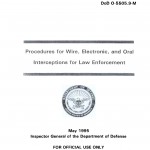This Study Plan outlines the background, scope, strategic assumptions, study objectives, analysis methodology, scenario considerations, timeline, and management responsibilities in conducting the Homeland Defense and Civil Support Capabilities-based Assessment (HD/CS CBA) to include production of the Functional Area Analysis (FAA), Functional Needs Analysis (FNA) and a Joint Capabilities Document (JCD). This CBA, through the execution of the FAA, FNA. And JCD; identifies, describes, documents, and prioritizes DOD’s capability gaps and excesses in the HD/CS mission areas (to include the Mission Assurance (MA) function).
Read more →

